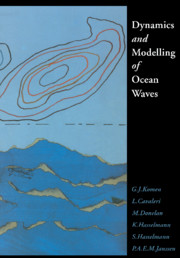Book contents
- Frontmatter
- Contents
- Contributors
- Preface
- Chapter I Basics
- Chapter II The physical description of wave evolution
- Chapter III Numerical modelling of wave evolution
- Chapter IV Applications to wave hindcasting and forecasting
- Chapter V Global satellite wave measurements
- Chapter VI Wave data assimilation and inverse modelling
- Chapter VII Summary and outlook
- Members of the WAM group
- Affiliations and addresses of contributors
- Notation and abbreviations
- References
- Index
Chapter VII - Summary and outlook
Published online by Cambridge University Press: 22 January 2010
- Frontmatter
- Contents
- Contributors
- Preface
- Chapter I Basics
- Chapter II The physical description of wave evolution
- Chapter III Numerical modelling of wave evolution
- Chapter IV Applications to wave hindcasting and forecasting
- Chapter V Global satellite wave measurements
- Chapter VI Wave data assimilation and inverse modelling
- Chapter VII Summary and outlook
- Members of the WAM group
- Affiliations and addresses of contributors
- Notation and abbreviations
- References
- Index
Summary
Summary and outlook
The WAM group has realized its objectives: a third generation wave model has been developed; it runs in global and regional modes; it extended our understanding of the underlying physics; and data assimilation schemes have been developed and tested. This book is testimony of what has been achieved. However, careful reading will also reveal open ends, which range from small inconsistencies to major open issues. In this chapter we give an outlook on expected developments.
Compared to the so-called second generation models considerable progress has been made regarding the formulation of the evolution equation for the wave spectrum. The present WAM model is based on an explicit formulation of the physics of generation of waves by wind, nonlinear wave-wave interactions and dissipation due to whitecapping and bottom processes, rather than on the approach of ad hoc modelling which was commonplace with second generation models. The latter approach was shown to be inadequate under extreme circumstances such as hurricanes (SWAMP, 1985), while the WAM model gives for rapidly varying wind fields very satisfactory results (see chapter IV). Nevertheless, under ‘normal’ circumstances both approaches give similar results for the wave height. The reason for this is that although second generation models have inadequate physics they have been tuned to a considerable extent. Thus, the benefits of a third generation model are mainly related to a better representation of the spectrum itself and to a more explicit formulation of the underlying physics of wave evolution.
Despite the progress, we still are not able to make wave predictions that always fall within the error bands of the observations.
Information
- Type
- Chapter
- Information
- Dynamics and Modelling of Ocean Waves , pp. 481 - 486Publisher: Cambridge University PressPrint publication year: 1994
